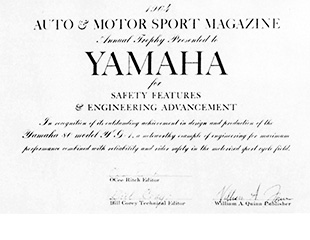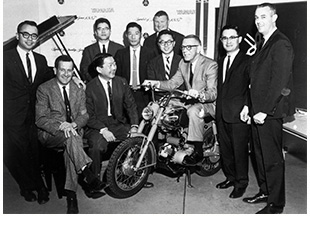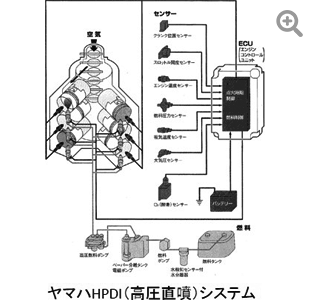Awards
Introducing the stories behind Yamaha Motor's technologies.
- Search Tab ››
- Year
- Award
- Technology
- IBEX Innovation Awards
- JSAE Awards
- SETC Award
- APAC Best Paper Award
- Oyamada Medal
- TPM Excellence Awards
- Ichimura Industrial Award: Contribution Prize
- Others
2025 Sokeizai Industry Technology Award
- Awarded
- Development of Iron-Aluminum Metal Flow Joining Technology
Application to Powertrain Components - Achieved significant weight reduction (68% reduction) in CVT transmission sheaves through “Metal Flow Joining,” which physically joins dissimilar materials without forming intermetallic compounds. Reduced energy use during manufacturing by 45%, while also excelling in mass-producibility and recyclability, cutting manufacturing costs by 88% (wrought aluminum alloy).
Utilizing DX technology, we established a comprehensive quality traceability system linking individual identification with manufacturing data across multiple sites. - Recipient(s)
- Masashi Takatoo, Yoshiteru Makise
Manufacture Technology Division, Manufacturing Technology Center - Takuro Iwakata
1st PT Design & Development Division, Product Development Section, Powertrain Unit - Takeaki Nakazawa
PT Steel Components Engineering Division, Manufacturing Engineering Section, Manufacturing Center - Haruhiko Sugiyama
Materials Division, Manufacturing Technology Center - Shigeyuki Suzuki
Machinery R&D Division, Manufacturing Technology Center - Ryuzo Takahashi
KYOWA ALTECH Co. Ltd.
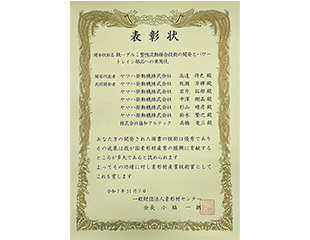
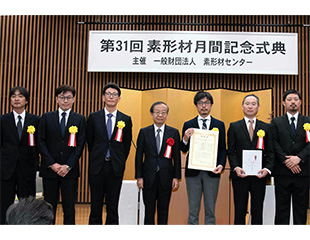
2024 JSME Excellence in Poster Presentation Award (TRANSLOG2023)
- Awarded
- A Study on Motorcycle Riding Training
Indexing of “Driving Characteristics” that visualize “running, turning, and stopping” movements extracted from GPS measurement data, and “Driving Proficiency” of piloting techniques focusing on reproducibility, and research on training methods using these indexes. - Recipient(s)
- Yoshitaka Kojima
Control System Development Division, Technical Development Section, Technical Research & Development Center
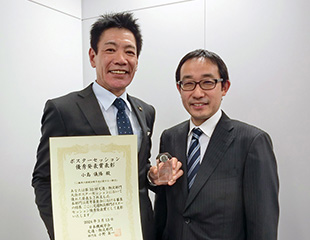
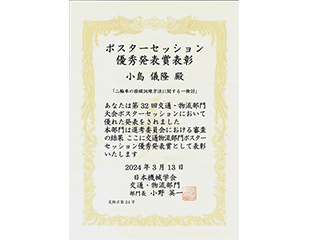
2024 IEEJ Industry Applications Society Excellent Presentation Award (Paper published in 2023)
- Awarded
- Operating Characteristics of Adjustable Field PM Motor with 3D Magnetic Path and Asymmetric PM Arrangement
(Results of a joint research project with the Noguchi and Iwama Laboratory at Shizuoka University) - Recipient(s)
- Yutaro Hiyoshi
Engineering Division 2, Automotive Development Section, Technical Research & Development Center
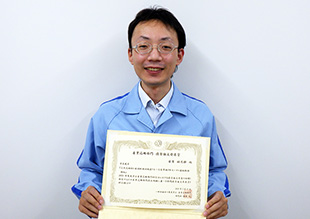

2024 ITEC-AP (Asia-Pacific) 2023 Best Paper Award
- Awarded
- Operating Characteristic of Adjustable-Field Permanent Magnet Motors with 3D Magnetic Paths and Asymmetric Magnet Arrangement
Development of 1) a structure that can electrically control the magnetic force generated by the rotor of a variable field motor and 2) a method to improve efficiency that achieves both high-torque operation and highly efficient operation at high-speed, low-torque ranges.
(Results of a joint research project with the Noguchi and Iwama Laboratory at Shizuoka University) - Recipient(s)
- Yutaro Hiyoshi
Engineering Division 2, Automotive Development Section, Technical Research & Development Center

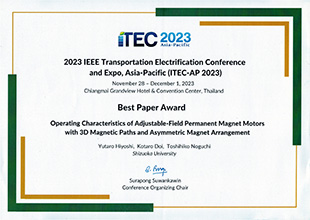
2023 The Japan Institute of Light Metals (JILM) Light Metal Advancement Award
- Awarded
- Outstanding contributions to the body of academic research and technological development concerning light metals contributing to weight reduction with motorcycles, i.e., research into aluminum alloys; research for improving the durability of parts made of titanium alloys; R&D of vacuum die-casting technology, fatigue characteristics, bright heat treatment, coating technology, and more that led to the practical use of magnesium alloys for large parts like wheels and subframes; and other studies.
- Recipient(s)
- Takaharu Suzuki
Materials Division, Manufacturing Technology Center
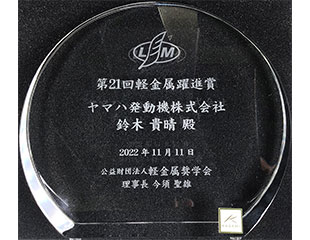
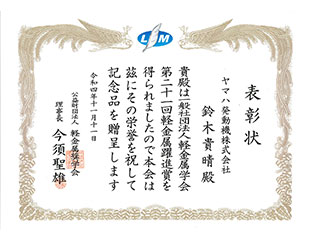
2022 ICEE (The International Council on Electrical Engineering Conference) 2022 Best Oral Award
- Awarded
- Experimental Study on Low-Speed Control for Motorcycles Using SPACAR Model and Gain-Scheduling Control
- This study examined using SPACAR—a flexible multibody dynamics analysis and simulation software—for the creation of a vehicle dynamics model for motorcycles traveling at low speeds of no more than 10 km/h, at which tires do not slide. An optimal design method using a speed-dependent scale model and weights was used to calculate feedback control gains, and the speed-dependent gains were used to verify stable vehicle response at a speed no more than 1.5 km/h (slower than the average walking speed) with both simulations and a prototype vehicle.
(Results of a joint research project with the Susumu Hara Laboratory in the Department of Aerospace Engineering at the Graduate School of Engineering of Nagoya University) - Recipient(s)
- Mitsuo Tsuchiya
Digital Engineering Division, Digital Development Section, Technical Research & Development Center - Tetsuya Kimura
R&D Strategy Division, New Venture Business Development & R&D Strategy Section, Technical Research & Development Center
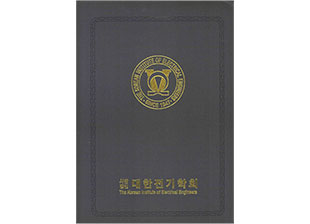
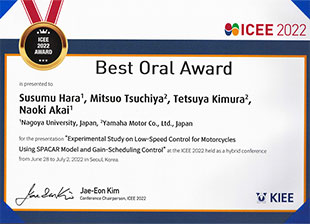
2022 SCIE Chubu Branch Technology Award / Business-Academia Cooperation Award
- Awarded
- Robust control design for self-standing when stopped and at very low speeds in the automated motorcycle MOTOROiD
- A major advancement was achieved in the robustness of the self-standing function of the motorcycle concept model MOTOROiD (introduced 2017). The adoption of a sliding-mode control system with high-frequency cutoff characteristics contributed to a dramatic improvement in the control unit capacity to sense and adjust to external disturbances. And this was achieved without requiring any changes in the machine’s chassis design.
A joint research project with Susumu Hara, Professor, Ph.D., Department of Aerospace Engineering, Graduate School of Engineering, Nagoya University, led to a beneficial coexistence of different requirements: improvement of the self-standing function and suppression of the residual mode. - Recipient(s)
- Mitsuo Tsuchiya
Digital Engineering Division, Digital Development Section, Technical Research & Development Center - Tetsuya Kimura
R&D Strategy Division, New Venture Business Development & R&D Strategy Section, Technical Research & Development Center
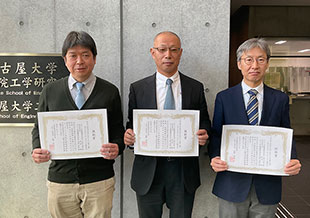
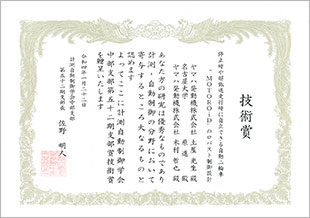
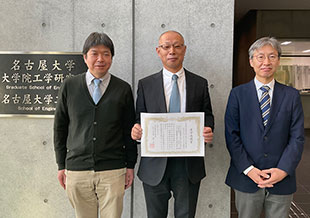
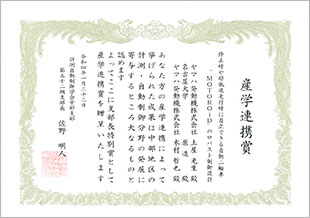
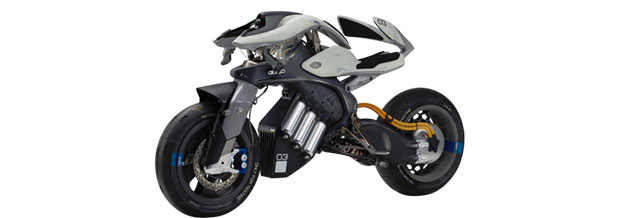
2019 Japan Foundry Engineering Society Castings of the Year Award
- Awarded
- Lightweight, high-rigidity aluminum wheels
- These cast aluminum wheels for a sport Leaning Multi-Wheel (LMW)* model feature both light weight and high rigidity achieved through finite element analysis (FEA), which enables more realistic modeling, mid-cast solidification analysis to increase strength and resistance to pressure, and other engineering processes.
*Yamaha Motor’s designation for vehicles with three or more wheels that can lean through turns like a motorcycle. - Recipient(s)
- Kentaro Suenaga
Power Train Engineering Division, Production Engineering Section, Manufacturing and Production Engineering Center
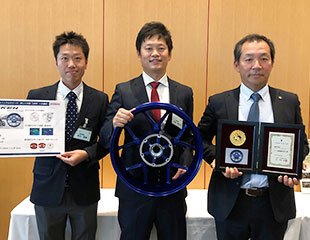
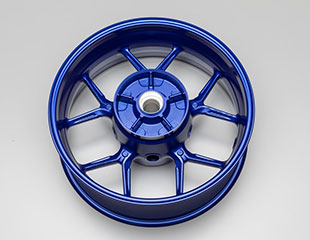
2019 The Commendation for Science and Technology by the Minister of Education, Culture, Sports, Science and Technology: Prizes for Science and Technology (Development Category)
- Awarded
- Development of Control Systems for Industrial-use Unmanned Helicopters
- Recipient(s)
- Katsu Nakamura
Unmanned System Section, Robotics Business Unit, Solution Business Operations

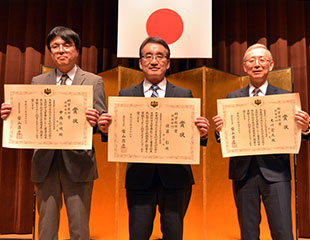
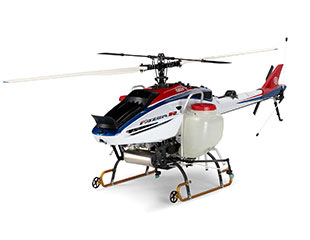
- Awarded
- Study on self-standing motorcycle control mechanism (AMCES)
- AMCES is a high-precision balance control mechanism governed via artificial intelligence and autonomous technology. Equipped on the MOTOROiD concept model, this allows the machine to sense its own state and adjust its center of gravity accordingly to stand up off its kickstand and remain upright unassisted.
- Recipient(s)
- Mitsuo Tsuchiya
Digital Engineering Division, Digital Development Section, Mobility Technology Center - Eiichiro Tsujii
Planning Division, New Venture Business Development Section, Advanced Technology Center - Takashi Terayama
Engineering Division 2, Automotive Business Unit - Takashi Tsurumi
Fundamental Technology Research Division, Research & Development Section, Advanced Technology Center
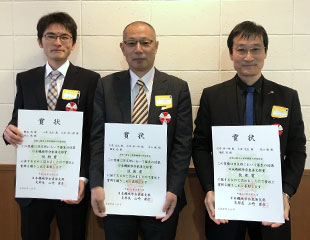
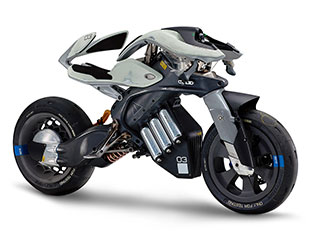
2018 SLAS New Product Award
- Awarded
- CELL HANDLER™
- The cell picking & imaging system CELL HANDLER™ applies Yamaha’s surface mount technology originally developed for mounting electronic parts on printed circuit boards. CELL HANDLER™ rapidly and accurately transfers target cells to microplates for culturing or evaluations and analyzes images captured during drug discovery and development, efficacy tests for anti-cancer agents, etc.
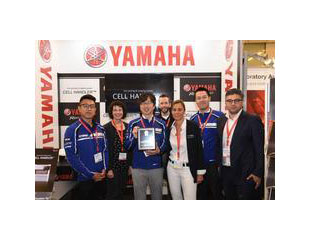
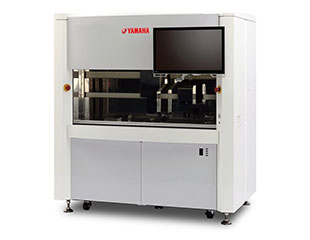
2017 Interbike Product Innovation Awards
- Awarded
- PW-X
- This electric power-assist system designed for mountain bikes consists of easy-to-use ergonomic switches, an LCD display and a drive unit with lower weight and greater levels of compactness over its predecessor.
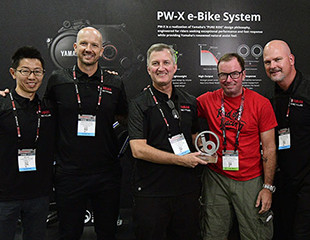
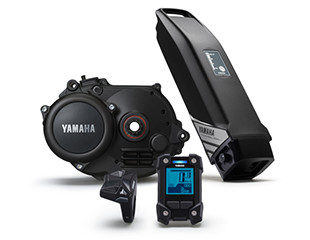
2017 Sokeizai Industry Technology Award
- Awarded
- Development of a new manufacturing method for aluminum motorcycle fuel tanks
- Recipient(s)
- Yoshihiro Kimura, Noboru Mitsui, Masatoshi Miyamoto, Gou Nagura, Kazuya Iida, Kyosuke Nomura
Manufacture Technology Division, Component Section, Engine Unit
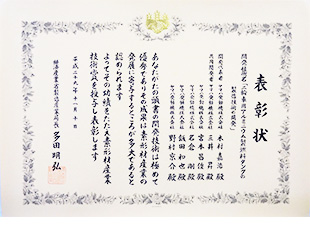
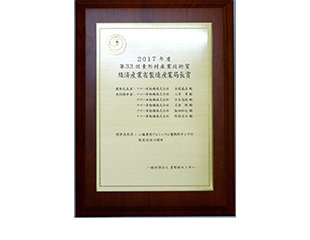
2017 Japan Boat of the Year: Special Award
- Awarded
- Helm Master
- This control system for outboard-mounted boats provides electronic control of all the steering, gear shifting and throttle functions, etc., to allow intuitive control of the boat via a single joystick for maneuvering through narrow waterways, when docking or setting off and the like.
- Recipient(s)
- Isao Kanno
Research & Development Section, Marine Engine Business Unit
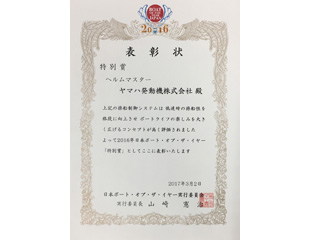
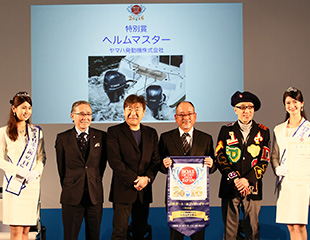
- Awarded
- The Development of the Ceramics Nano-Film Coating Having Both High Corrosion Resistance and Excellent Heat Resistance
- Recipient(s)
- Naohisa Takahashi
Materials Division, Component Section, Engine Unit
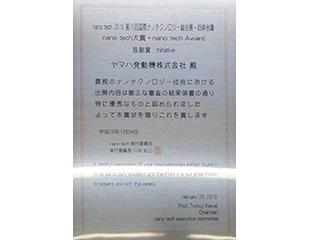
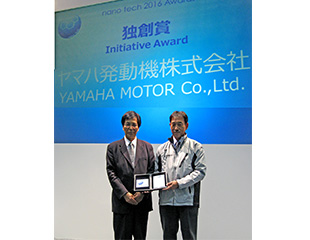
2010 Sokeizai Industry Technology Award
- Awarded
- Development of magnesium die-casting technology for large, thin-walled vehicle chassis parts
- Recipient(s)
- Toshikatsu Koike, Junichi Inami, Atsushi Suzuki, Kenji Tsukamoto, Takaharu Suzuki
Material Division, Research & Development Operations
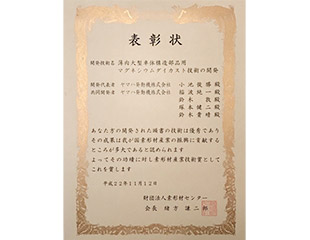
2006 JIM Technical Development Award
- Awarded
- Development of New Advanced Stainless Steel “NSSC21M” for Catalysis Substrate of Motorcycle Muffler
- Recipient(s)
- Naohisa Takahashi, et al.
Materials Division, Component Section, Engine Unit


2005 JDCA Urakami Award
- Awarded
- Development of an All-Aluminum Cylinder Using a Hypereutectic Al-Si Alloy
- Recipient(s)
- Hirotaka Kurita, Hiroshi Yamagata
Advanced Technology Research, Research & Development Operations
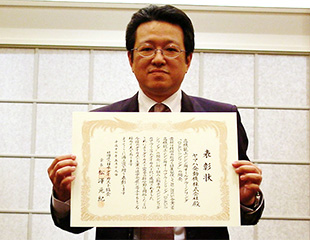
2005 JSPMI Chairman's Prize
- Awarded
- Development of the Performance Damper
- Recipient(s)
- Seiji Sawai, Kouji Sakai, Katsuhiro Kondou, Masahiro Satou
Automotive Business Unit
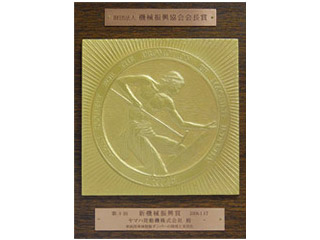
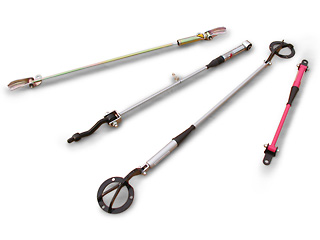
2005 JSTP Tokai Branch Technology Award
- Awarded
- Development of Fracture Splitting Method for Case Hardened Connecting Rods
- Recipient(s)
- Tsuyoshi Kubota, Shinya Iwasaki, Tsuneo Isobe, Toshikatsu Koike
Materials Division, Component Section, Engine Unit
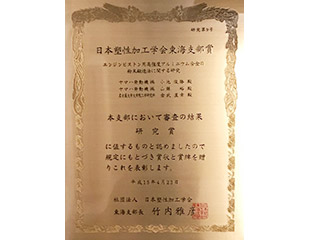
2003 SFJ Technology Award
- Awarded
- Hard Anodic Oxide Coating on the Piston-Ring Groove of a Cu-Rich Aluminum Piston with Mixed Acid Electrolytes
- Recipient(s)
- Hirotaka Kurita, Hiroshi Yamagata, Toshikatsu Koike, et al.
Advanced Technology Research, Research & Development Operations

2000 Boating Week Innovation Award
- Awarded
- F225
- The F225 featured an internal layout which reversed the configuration of the air intake and exhaust systems to create an “in-bank exhaust system,” a first for an outboard motor. Compared to other models with similar horsepower, the 4-stroke F225 was significantly lighter and more compact.
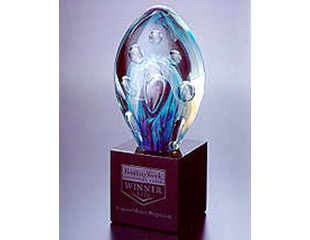

2000 MotorBoating and Sailing Award
- Awarded
- High Pressure Direct Injection (HPDI)
- Compared to conventional direct-injection systems of the time that used pressures of around 20 bar (290 psi), this fuel injection system for outboard motors made it possible to inject fuel at much higher pressures of 50 bar (725 psi). By reducing the injection spray into finer particles, it improved combustion efficiency, thus lowering fuel consumption and producing cleaner emissions.
2000 Popular Mechanics Design and Engineering Award
- Awarded
- High Pressure Direct Injection (HPDI)
- Compared to conventional direct-injection systems of the time that used pressures of around 20 bar (290 psi), this fuel injection system for outboard motors made it possible to inject fuel at much higher pressures of 50 bar (725 psi). By reducing the injection spray into finer particles, it improved combustion efficiency, thus lowering fuel consumption and producing cleaner emissions.
1999 MotorBoating and Sailing Award
- Awarded
- F100
- This 1,596cc inline 4-cylinder 100 hp 4-stroke outboard motor featured the world’s first 16-valve DOHC engine.
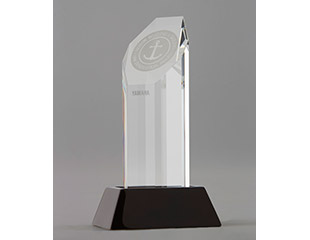
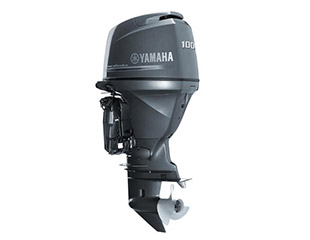
1998 JSPM Award for Innovative Development
- Awarded
- Development of SiC-Composite-PM Aluminum Alloy Piston
- Recipient(s)
- Toshikatsu Koike, Hiroshi Yamagata
Fundamental Technology Research, Technology Center

1997 JSTP Technological Development Award
- Awarded
- A Newly Developed Forging Technique for High-Performance Pistons
- Recipient(s)
- Toshikatsu Koike, Hiroshi Yamagata
Fundamental Technology Research, Technology Center
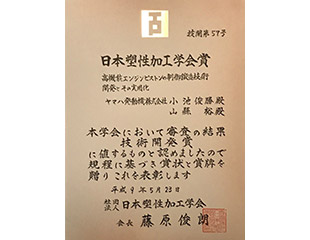
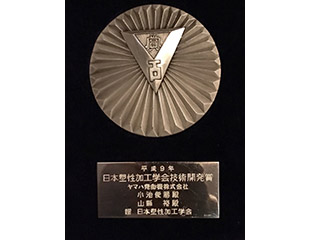
1994 JSPMI Chairman's Prize
- Awarded
- Development of Electrically Power-Assisted Bicycles
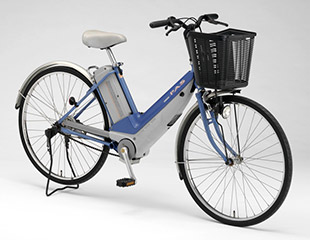
1992 Popular Mechanics Design and Engineering Award
- Awarded
- Hydra Drive Propulsion System
- Thanks to the use of a hydraulic clutch and other features, this propulsion unit for stern drives provided incredibly smooth gearshifts, something considered groundbreaking at the time.
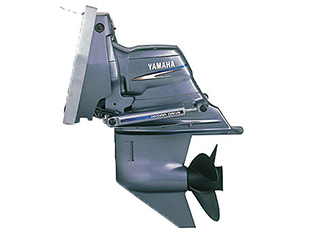
1991 Energy Conservation Prize: Outstanding Product Award
- Awarded
- Multi-purpose 3 hp 3-room Yamaha gas-powered air conditioning system
- This cost-effective Gas Heat Pump (GHP) air conditioner system used engine exhaust heat to enhance heat exchange efficiency, and was especially effective when utilized for heated flooring and the like.
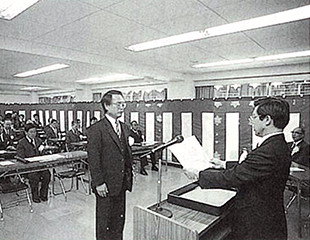
1990 FISITA World Automotive Congress Outstanding Paper Award
- Awarded
- Traction Drive CVT for Motorcycle
- Recipient(s)
- Yasushi Ichihara
Motorcycle Center, Testing Group
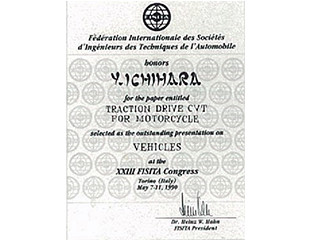
1989 The Japan Gas Association Technology Award
- Awarded
- Development of a compact gas-heater pump
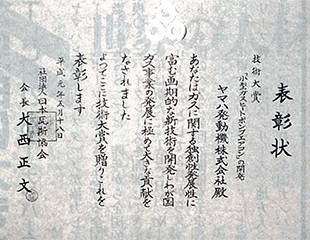
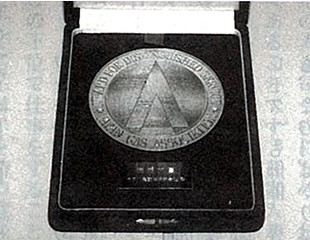
1988 Prizes for Creativity in the Workplace: Director General of the Science and Technology Agency Award
- Awarded
- Design of a compact automatic cleaning machine
- Recipient(s)
- Taketsugu Suzuki
Production Department 21
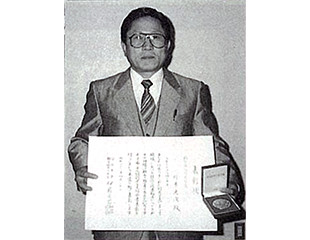
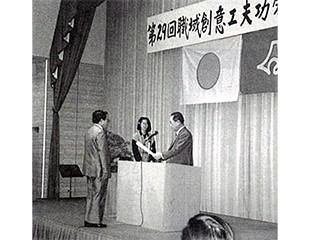
1987 Japan Lead Zinc Development Association Chairman’s Prize
- Awarded
- Practicalization of ZA-12 alloy
- Recipient(s)
- Yamada
1st Research Division
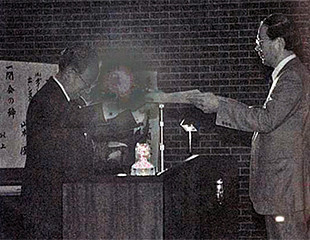
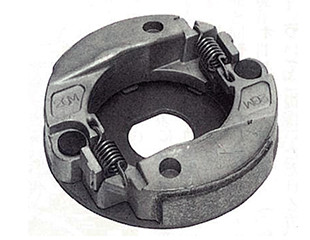
1987 PackOsaka Exhibition Packaging and Logistics Technology Contest Silver Medal
- Awarded
- New packaging system for fuel tanks
- Recipient(s)
- Parts Business Unit
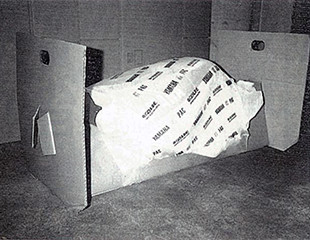
1986 Governor of Shizuoka Prefecture Award
- Awarded
- Invention and design of the Yamaha Rapid Plating System
- Recipient(s)
- Hiroshi Tsukakoshi
R&D Division
Toshiyuki Suzuki
Purchasing Management Division
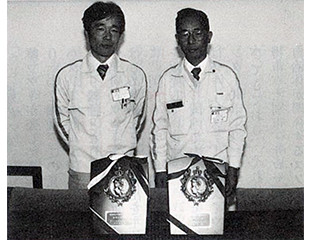
1986 The New Seven Basic Tools of Quality Association Prize for Excellence
- Awarded
- Study of Prioritization and Evaluation Methods for Planning and Management Work: Improving Target Management Approaches in the Manufacturing Technology Planning Department
- Recipient(s)
- Dai Kawasaki
Production Department 31
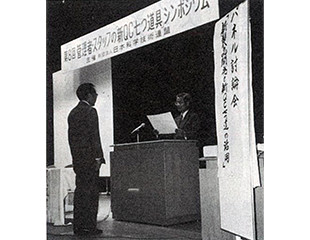

1985 Tomizuka Prize
- Awarded
- R&D and practicalization of an exhaust timing control system for high-performance 2-stroke engines (Yamaha Power Valve System)
- Recipient(s)
- Masayasu Mizoguchi
Motor Sports Development Operations

1984 Japan Society of Mechanical Engineers Medal
- Awarded
- LDV Measurements of Pipe Flows in a Small-Two-Cycle Spark-Ignition Engine
- Recipient(s)
- Noritaka Matsuo
Research Division
Yoshio Hirano, et al.
Power Products Business Unit
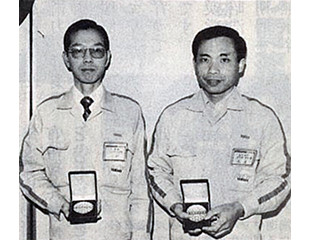
1964 Auto & Motor Sport Magazine Annual Trophy
- Awarded
- YG-1
- This motorcycle’s 2-stroke 75cc 6.5 hp single-cylinder engine featured a cutting-edge rotary disc valve intake and was mounted in a lightweight and compact 70 kg chassis, resulting in outstanding performance and reliability.
